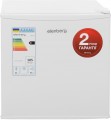Total capacity
The total capacity of the refrigerator is the total capacity of all the main working chambers: refrigerating, freezing, zero, and wine chambers. The set of these chambers, of course, will be different in different models (see more about them above). Here we note that large volumes, on the one hand, simplify the storage of numerous products and, on the other hand, affect the dimensions and price of the unit. It is also worth considering that refrigerators of the same total capacity may differ in the capacity of individual chambers.
Refrigerator capacity
The total capacity of the main working chamber of the refrigerator. If there are separate zero chambers, compartments for wine and other additional functions, this paragraph takes into account only the volume of the refrigerating chamber itself, without additional equipment. In the smallest modern units, this figure
does not even reach 100 liters, in the largest it can exceed
400 liters.
The choice of capacity depends on the actual storage needs of the products. At the same time, both the volume of stocks and the frequency of their replenishment (every day, once a week, etc.) matter. The chamber should not be stocked completely; this adversely affects the quality of the refrigerator. On the other hand, it is worth remembering that large volumes accordingly affect the dimensions and price of the unit.
In general, for one or two people, a capacity of
200 – 250 liters, or even less, is considered quite sufficient. The optimal capacity for a family of three is about
250 – 300 liters, for four to five people —
300 – 350 liters, and larger volumes are really needed mainly for specific situations when food has to be stored in large quantities and for a long time.
Energy consumption per year
The average amount of energy consumed by a refrigerator in a year of operation. Of course, these figures are not absolutely accurate; the actual power consumption may vary depending on the specific operating conditions. However, this parameter makes it possible to evaluate the power consumption of the refrigerator and compare different models with each other. At the same time, it often turns out to be more convenient and visual than the energy consumption class (see above) because in this paragraph we are talking about a specific figure (from which you can also calculate the cost of electricity consumed). For clarity, let's take the following example: a small two-chamber refrigerator with energy class A can consume less energy per year than a large side-by-side unit of class A+++, although formally, in terms of energy consumption classes, the second model will be more economical than the first.
Climate class
The climate class to which the refrigerator corresponds.
As the name implies, this parameter describes the environmental conditions for which the unit is designed. The warmer it is around — the more powerful the refrigerator should be and the better thermal insulation it should have. Specific classes are indicated by letters, here are the most popular options:
—
SN (subnormal). Models for a temperate cool climate, have an operating range from +10 °C to + 32 °C. Such a unit can be useful in a poorly heated room where the temperature can drop below +16 °C — for example, on the veranda of a private house, in a garage, etc.
—
N (normal). Refrigerators for temperate climates, with an operating temperature range of +16...+32 °C. Such a unit is suitable for most residential apartments and houses in mid-latitudes.
—
ST (subtropical). Models for subtropical and humid tropical climates. Normally work at the range of external temperatures +18...+38 °C.
—
T (tropical). Refrigerators for dry tropical climates. Designed for temperature range +18 °С to +43 °С.
There are many models on the market with an extended temperature range covering several classes. For example, a unit labelled N-ST will have a temperature range of +16...+38 °C. Such refrigerators are indispensable in complicated
...climates, the conditions of which are not covered by one standard class — for example, during cold winters and hot summers.Noise level
The average noise level generated by the refrigerator during operation.
The
quietest models of refrigerators are noisy at a level of about 30 dB — this volume is comparable to the whispering or ticking of a wall clock and does not exceed the sanitary standards for residential premises at night. In other words, such a unit will not interfere with sleep, even if it is placed right in the bedroom. At the same time, the standard place for a refrigerator is still a kitchen, and with such an installation it is isolated from other living quarters. Therefore, the noise of 40 – 42 dB, corresponding to a quiet conversation, is considered quite acceptable for ordinary household refrigerators. And with good sound insulation, a volume of up to 50 dB is allowed — this is the level of conversation at an average volume.
Higher values are rare among refrigerators and are mainly found in display refrigerators(see "Product type") installed in shops where noise levels are not as much important.

